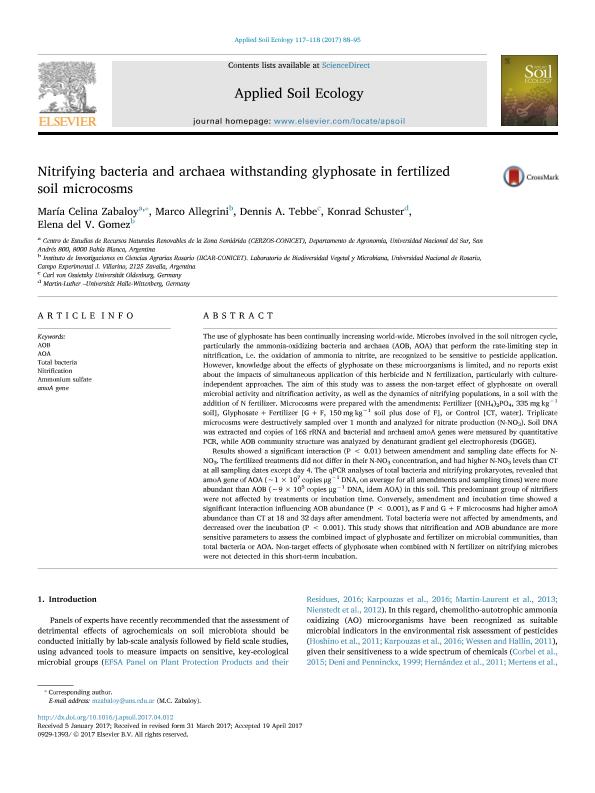Mostrar el registro sencillo del ítem
dc.contributor.author
Zabaloy, Maria Celina

dc.contributor.author
Allegrini, Marco

dc.contributor.author
Tebbe, Dennis A.
dc.contributor.author
Schuster, Konrad
dc.contributor.author
Gomez, Elena del Valle

dc.date.available
2018-07-26T16:00:49Z
dc.date.issued
2017-09
dc.identifier.citation
Zabaloy, Maria Celina; Allegrini, Marco; Tebbe, Dennis A.; Schuster, Konrad; Gomez, Elena del Valle; Nitrifying bacteria and archaea withstanding glyphosate in fertilized soil microcosms; Elsevier Science; Applied Soil Ecology; 117-118; 9-2017; 88-95
dc.identifier.issn
0929-1393
dc.identifier.uri
http://hdl.handle.net/11336/53164
dc.description.abstract
The use of glyphosate has been continually increasing world-wide. Microbes involved in the soil nitrogen cycle, particularly the ammonia-oxidizing bacteria and archaea (AOB, AOA) that perform the rate-limiting step in nitrification, i.e. the oxidation of ammonia to nitrite, are recognized to be sensitive to pesticide application. However, knowledge about the effects of glyphosate on these microorganisms is limited, and no reports exist about the impacts of simultaneous application of this herbicide and N fertilization, particularly with culture-independent approaches. The aim of this study was to assess the non-target effect of glyphosate on overall microbial activity and nitrification activity, as well as the dynamics of nitrifying populations, in a soil with the addition of N fertilizer. Microcosms were prepared with the amendments: Fertilizer [(NH4)2PO4, 335 mg kg−1 soil], Glyphosate + Fertilizer [G + F, 150 mg kg−1 soil plus dose of F], or Control [CT, water]. Triplicate microcosms were destructively sampled over 1 month and analyzed for nitrate production (N-NO3). Soil DNA was extracted and copies of 16S rRNA and bacterial and archaeal amoA genes were measured by quantitative PCR, while AOB community structure was analyzed by denaturant gradient gel electrophoresis (DGGE). Results showed a significant interaction (P < 0.01) between amendment and sampling date effects for N-NO3. The fertilized treatments did not differ in their N-NO3 concentration, and had higher N-NO3 levels than CT at all sampling dates except day 4. The qPCR analyses of total bacteria and nitrifying prokaryotes, revealed that amoA gene of AOA (∼1 × 107 copies μg−1 DNA, on average for all amendments and sampling times) were more abundant than AOB (∼9 × 105 copies μg−1 DNA, idem AOA) in this soil. This predominant group of nitrifiers were not affected by treatments or incubation time. Conversely, amendment and incubation time showed a significant interaction influencing AOB abundance (P < 0.001), as F and G + F microcosms had higher amoA abundance than CT at 18 and 32 days after amendment. Total bacteria were not affected by amendments, and decreased over the incubation (P < 0.001). This study shows that nitrification and AOB abundance are more sensitive parameters to assess the combined impact of glyphosate and fertilizer on microbial communities, than total bacteria or AOA. Non-target effects of glyphosate when combined with N fertilizer on nitrifying microbes were not detected in this short-term incubation.
dc.format
application/pdf
dc.language.iso
eng
dc.publisher
Elsevier Science

dc.rights
info:eu-repo/semantics/openAccess
dc.rights.uri
https://creativecommons.org/licenses/by-nc-sa/2.5/ar/
dc.subject
Ammonium Sulfate
dc.subject
Amoa Gene
dc.subject
Aoa
dc.subject
Aob
dc.subject
Nitrification
dc.subject
Total Bacteria
dc.subject.classification
Otras Ciencias Biológicas

dc.subject.classification
Ciencias Biológicas

dc.subject.classification
CIENCIAS NATURALES Y EXACTAS

dc.subject.classification
Agricultura

dc.subject.classification
Agricultura, Silvicultura y Pesca

dc.subject.classification
CIENCIAS AGRÍCOLAS

dc.title
Nitrifying bacteria and archaea withstanding glyphosate in fertilized soil microcosms
dc.type
info:eu-repo/semantics/article
dc.type
info:ar-repo/semantics/artículo
dc.type
info:eu-repo/semantics/publishedVersion
dc.date.updated
2018-07-26T13:58:14Z
dc.journal.volume
117-118
dc.journal.pagination
88-95
dc.journal.pais
Países Bajos

dc.journal.ciudad
Amsterdam
dc.description.fil
Fil: Zabaloy, Maria Celina. Consejo Nacional de Investigaciones Científicas y Técnicas. Centro Científico Tecnológico Conicet - Bahía Blanca. Centro de Recursos Naturales Renovables de la Zona Semiárida. Universidad Nacional del Sur. Centro de Recursos Naturales Renovables de la Zona Semiárida; Argentina
dc.description.fil
Fil: Allegrini, Marco. Consejo Nacional de Investigaciones Científicas y Técnicas. Centro Científico Tecnológico Conicet - Rosario. Instituto de Investigaciones en Ciencias Agrarias de Rosario. Universidad Nacional de Rosario. Facultad de Ciencias Agrarias. Instituto de Investigaciones en Ciencias Agrarias de Rosario; Argentina
dc.description.fil
Fil: Tebbe, Dennis A.. Carl von Ossietzky Universität Oldenburg; Alemania
dc.description.fil
Fil: Schuster, Konrad. Universität Halle-Wittenberg; Alemania
dc.description.fil
Fil: Gomez, Elena del Valle. Consejo Nacional de Investigaciones Científicas y Técnicas. Centro Científico Tecnológico Conicet - Rosario. Instituto de Investigaciones en Ciencias Agrarias de Rosario. Universidad Nacional de Rosario. Facultad de Ciencias Agrarias. Instituto de Investigaciones en Ciencias Agrarias de Rosario; Argentina
dc.journal.title
Applied Soil Ecology

dc.relation.alternativeid
info:eu-repo/semantics/altIdentifier/doi/https://dx.doi.org/10.1016/j.apsoil.2017.04.012
dc.relation.alternativeid
info:eu-repo/semantics/altIdentifier/url/https://www.sciencedirect.com/science/article/pii/S0929139317300276
Archivos asociados
